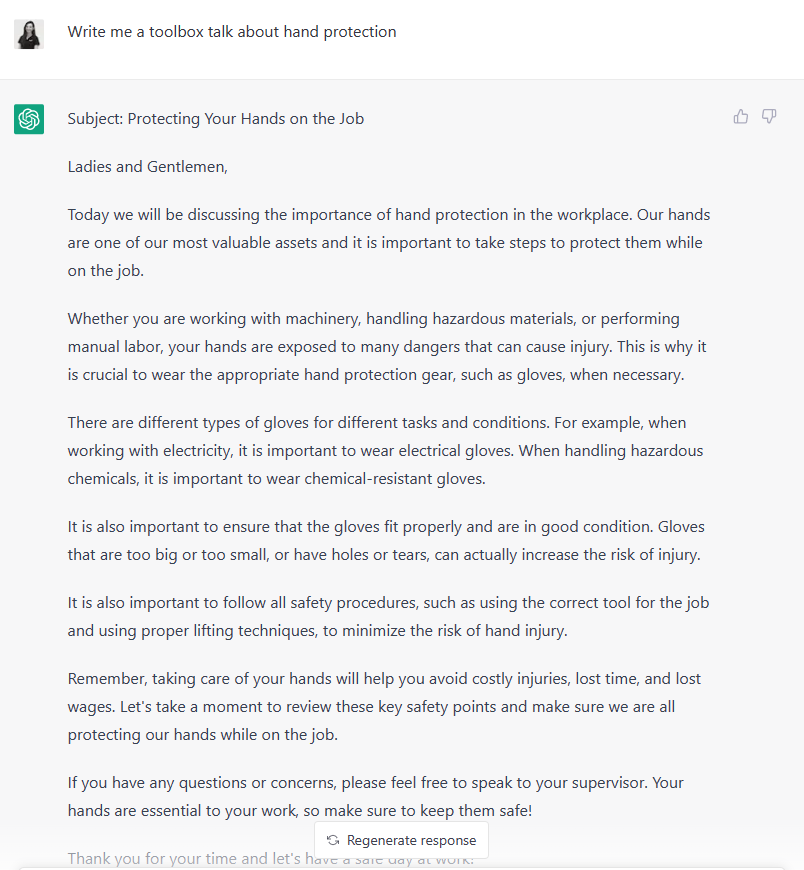There’s much ado about how ChatGPT will affect students, developers, and marketers, but what about Environmental, Health & Safety (EHS)? How can this new OpenAI technology augment the EHS professional’s role?
So far, I’ve asked ChatGPT to explain bitcoin, write a short history of Toronto, and create a toolbox talk on hand safety, among other things. It did an OK job each time, which is better than I expected—so I’m left wondering what else it can do.
Disclaimer: I did not get ChatGPT to write this article!
What is ChatGPT?
ChatGPT is a natural language processing (NLP) program that facilitates text-based conversation between a human and a machine.
It’s taken the world by storm, reaching 1 million users in just 5 days.
What makes ChatGPT different to Siri or Alexa is its ability to use deep learning to understand the context of questions in “natural” language and respond more accurately. In fact, 300 billion words were fed into the system by its creators, OpenAI.
I’ve co-written about AI in EHS in the past. One way of measuring where we are on the doomsday scale (I digress) is Artificial Narrow Intelligence, to General Intelligence, to Super Intelligence.
Narrow is when an AI is better than the best human at one thing, like mastering a game. General is when AI is as-good or better than humans at a range of things. Super is when AI outperforms humans across the board.
I expect we’re still in an advanced Narrow stage with ChatGPT, since it’s regurgitating information already available online, so although I believe this technology could be transformational, I’ll commit to no dramatic “what ifs?” herein.
What can EHS use ChatGPT for?
For EHS, there are several uses my colleagues and I can think of:
- Toolbox talks
- Form translation
- Scenario planning
- Identifying GHG emissions calculations
- Benchmarking
The preview version available to the public is capped at 2021 knowledge, so at least for now some of its responses will be outdated. However, this won’t be the case with the new version of ChatGPT integrated into Bing.
Even with the preview, the potential is clear. For example, here is what ChatGPT wrote when I asked for a toolbox talk about hand safety:
Figure 1: ChatGPT's response to my request for a toolbox talk on hand protection
Granted, I don’t know how many real people start their toolbox talk with “Ladies and Gentlemen,” however. Maybe ChatGPT is on to something. Not great, not bad.
But without a doubt: quick.
In another example, I asked ChatGPT to tell me what information and formulas I needed to calculate my company’s greenhouse gas emissions.
I won’t paste the lengthy response, but it was significantly more helpful in a shorter space of time versus my old method: googling.
In fact, as we had a bit of fun asking ChatGPT what to order from the local takeout for dinner, my partner commented, “It’s basically a better Google.”
However, it’s still prudent to fact check AI chatbots. ChatGPT’s competitor from Google, Bard, caused $100BN to be wiped off Alphabet’s market value over a mistake.
ChatGPT saves EHS time
Personally, I believe the value of ChatGPT lies in saving time… currently.
In my case, instead of spending more hours trawling through SASB and TCFD documentation to inform Pro-Sapien’s EHS software, by asking ChatGPT for help, in a matter of minutes I had answers to questions I’ve been investigating for weeks.
And with all my newfound time I wrote this post.
I came across a jarring quote recently on LinkedIn (clicking on a fair few links about ChatGPT has not gone unnoticed by the algorithm). I can’t find who said it, but it resonated with me: “AI will not steal your job. Someone who is comfortable using AI will steal your job.”
And with that, “Ladies and Gentlemen,” I close.
What other ways can you see ChatGPT being helpful in an EHS context?




